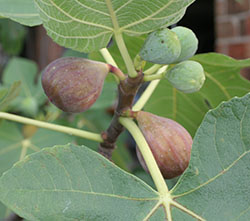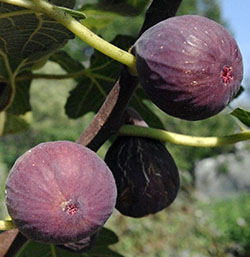Figs
The fig (Ficus carica L.) is native to western Asia through the Middle East and to the Mediterranean. Figs are harvested for both fresh consumption and processing. There are three main types of cultivated Ficus carica: Common, San Pedro and Smyrna. Common figs produce fruit parenthocarpically, without any pollination. Smyrna figs require pollen transfer from male trees that produce small caprifigs for fruit growth. Pollen transfer is obtained by the fig wasp (Blastophaga psenes L.), a species unable to survive the southern U.S. winter temperatures. San Pedro figs are intermediate between the two; a minor summer “breba” crop will set without fertilization but the later main crop requires pollination by the fig wasp. The common fig is the only type suggested for cultivation in the southern U.S.
Marketing
 California’s total fig production is about 30,000 metric tons annually. This volume is similar to the total production in countries like Brazil, Spain and Portugal. Most of California’s production is dried; some is used for canning, and about 10 percent is harvested for fresh use. Fresh figs are very perishable. The relative scarcity of fresh figs in the U.S. could make niche production feasible in Kentucky. However, producer caution is warranted due to the high probability that cold injury from Kentucky winter temperatures will affect productivity and may kill less hardy trees outright.
California’s total fig production is about 30,000 metric tons annually. This volume is similar to the total production in countries like Brazil, Spain and Portugal. Most of California’s production is dried; some is used for canning, and about 10 percent is harvested for fresh use. Fresh figs are very perishable. The relative scarcity of fresh figs in the U.S. could make niche production feasible in Kentucky. However, producer caution is warranted due to the high probability that cold injury from Kentucky winter temperatures will affect productivity and may kill less hardy trees outright.
Production
 Fig trees may grow taller than 40 feet in the southern and western U.S. However, trees will die back to the soil line from winter freeze damage and are often trained as bushes in climates like Kentucky. Select common figs with known cold tolerance and resistance to splitting and souring. ‘Celeste’ and ‘Chicago Hardy’ are two common fig cultivars, often planted in the southern U.S., with cold resistance to zero degrees F and 10 degrees F, respectively. Both are good for fresh use, drying and preserves. Select well-drained soils with at least eight hours of sunlight. Fig plantings near the southern side of a building are often recommended in colder climates such as Kentucky. Fig trees develop extensive, relatively shallow fibrous root systems and should not be planted near drainpipes, sewer lines or other underground infrastructure potentially affected by invasive roots.
Fig trees may grow taller than 40 feet in the southern and western U.S. However, trees will die back to the soil line from winter freeze damage and are often trained as bushes in climates like Kentucky. Select common figs with known cold tolerance and resistance to splitting and souring. ‘Celeste’ and ‘Chicago Hardy’ are two common fig cultivars, often planted in the southern U.S., with cold resistance to zero degrees F and 10 degrees F, respectively. Both are good for fresh use, drying and preserves. Select well-drained soils with at least eight hours of sunlight. Fig plantings near the southern side of a building are often recommended in colder climates such as Kentucky. Fig trees develop extensive, relatively shallow fibrous root systems and should not be planted near drainpipes, sewer lines or other underground infrastructure potentially affected by invasive roots.

